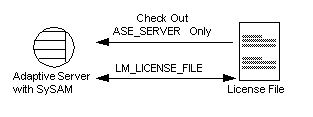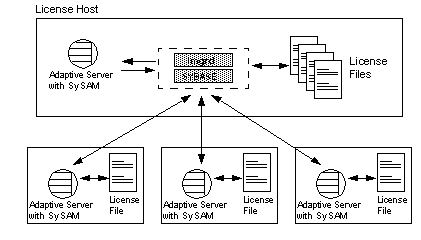The basic components of SySAM can be arranged for a standalone server, for a collection of servers on a network accessing a primary license host, and with multiple, redundant servers across a LAN or a WAN, for backup and load-balancing purposes.
Depending on which instance of Adaptive Server (primary or secondary servers) you are installing, the procedures for registering licenses vary.
In a standalone system, all of the SySAM components shown in Figure 3-2 reside on a single machine. The license file points directly to the asset management software, which runs on the same machine. This machine is called the license host.
Figure 3-2: Standalone system without optional features

In a network system, the license host runs SySAM, which handles check-in and check-out requests from all secondary servers, as shown in Figure 3-3.

The license files for secondary servers contain only pointers to the license host. Secondary servers check out licenses from the license host through the SySAM software.
![]() If you are using networked software asset management
system, you must install the software on the license host before
installing it on secondary servers.
If you are using networked software asset management
system, you must install the software on the license host before
installing it on secondary servers.
As part of a failover plan or a load-balancing system, you can have multiple servers running the same Adaptive Server configuration, using a redundant license across all servers. The redundant server system can be connected by a local-area network (LAN) or by a wide-area network (WAN).
A redundant server system is an excellent load-balancing mechanism for physically distant servers. The redundant license allows you to specify local servers as the first in the queue, and make remote servers available as backup. The SySAM application attempts to check out a license from a license-file list, starting with the first server. If that server fails for any reason, the second server in the list is contacted, and so on.
The redundant server system also provides failover protection. If one server in the list goes down for any reason, the second server responds to the license request. If that server fails too, the next server in the list is contacted, and so on.